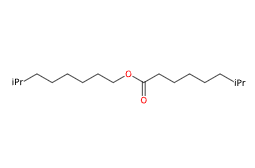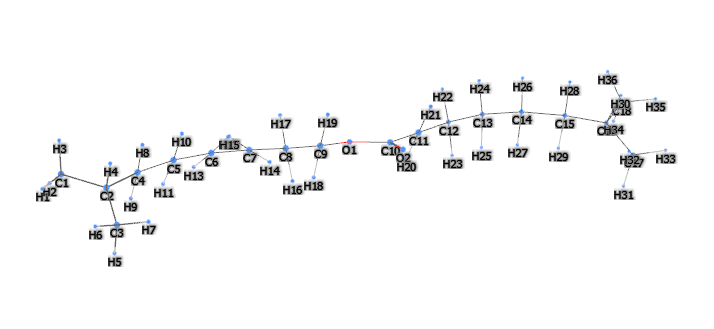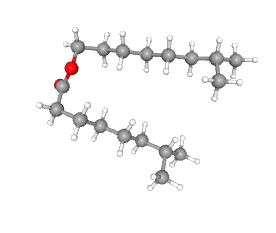| "Descrizione" by CarPas (5257 pt) | 2023-Jul-05 17:05 |
Review Consensus: 10 Rating: 10 Number of users: 1
| Evaluation | N. Experts | Evaluation | N. Experts |
|---|---|---|---|
| 1 | 6 | ||
| 2 | 7 | ||
| 3 | 8 | ||
| 4 | 9 | ||
| 5 | 10 |
AEC isononyl isononanoate (Isononyl isononanoate) is an organic chemical compound derived from pelargonic acid (isononanoic acid). A liquid monoester of odd medium chain branched alcohols and odd medium chain branched fatty acids, low viscosity-6mPa-s/25°C.
AEC isononyl isononanoate is a specific type of Isononyl Isononanoate that is produced by the AEC Group, a company that specializes in the production of chemicals for various industries, including cosmetics and personal care.
The name defines the structure of the molecule:
- AEC is the abbreviation for the company that produces this specific variant of Isononyl Isononanoate.
- Isononyl refers to the ester alcohol component, isononyl alcohol is a branched chain alcohol, which means it has a non-linear structure. It is derived from isononane, which is a hydrocarbon with nine carbon atoms.
- Isononanoate refers to the acid component of the ester. Isononanoic acid is a branched-chain fatty acid, also derived from isononane.
The synthesis process takes place in several stages:
- Esterification. The first phase consists in the esterification of Isononanoic acid with isononanol. This reaction is catalyzed by an acid, like sulfuric acid. The reaction produces water as a by-product, which is removed to bring the reaction to completion.
- Purification. the resulting product is then purified through distillation to remove any raw materials and unreacted by-products.
- Quality control. The final product is tested to ensure it meets the required specifications for purity and performance.
Presents as a white powder or colourless and odourless transparent liquid. High solubility for silicone oil, very stable in formulations containing silicone oil where it can solve the problem of silicone oil precipitation at low temperature.

What it is used for and where
Cosmetics
It acts as a coupling agent and stabiliser for silicone oils. Possesses low viscosity, good dispersion capacity for pigments, refreshing skin feel and non-greasy feel. Good dispersion capacity for pigments. Commonly known as synthetic silk oil. Used as an emollient, it has an elasticising effect on the skin and provides some protection to dry skin.
Skin-conditioning agent - Emollient. Emollients have the characteristic of enhancing the skin barrier through a source of exogenous lipids that adhere to the skin, improving barrier properties by filling gaps in intercorneocyte clusters to improve hydration while protecting against inflammation. In practice, they have the ability to create a barrier that prevents transepidermal water loss. Emollients are described as degreasing or refreshing additives that improve the lipid content of the upper layers of the skin by preventing degreasing and drying of the skin. The problem with emollients is that many have a strong lipophilic character and are identified as occlusive ingredients; they are oily and fatty materials that remain on the skin surface and reduce transepidermal water loss. In cosmetics, emollients and moisturisers are often considered synonymous with humectants and occlusives.
Antistatic agent. Static electricity build-up has a direct influence on products and causes electrostatic adsorption. The antistatic ingredient reduces static build-up and surface resistivity on the surface of the skin and hair.
Skin conditioning agent. It is the mainstay of topical skin treatment as it has the function of restoring, increasing or improving skin tolerance to external factors, including melanocyte tolerance. The most important function of the conditioning agent is to prevent skin dehydration, but the subject is rather complex and involves emollients and humectants that can be added in the formulation.
Used in skin care products, oily powder, foundation cream.
Dosage
- Make-up, skin care cleansing oil: 1-5%.
For more information:
| Appearance | Colorless transparent liquid |
| PSA | 26.30000 |
| LogP | 5.74260 |
 |  |
 |
- Molecular Formula C18H36O2
- Molecular Weight 284.5
- Exact Mass 284.27200
- CAS 42131-25-9 59219-71-5
- UNII S4V5BS6GCX
- EC Number 292-767-5 261-665-2
- DSSTox Substance ID DTXSID80962298
- IUPAC 7-methyloctyl 7-methyloctanoate
- InChI=1S/C18H36O2/c1-16(2)12-8-5-6-11-15-20-18(19)14-10-7-9-13-17(3)4/h16-17H,5-15H2,1-4H3
- InChl Key LHWUVOILCRBENG-UHFFFAOYSA-N
- SMILES CC(C)CCCCCCOC(=O)CCCCCC(C)C
- MDL number
- PubChem Substance ID
- SCHEMBL5807541
Synonyms
- 7-methyloctyl 7-methyloctanoate
- Lanol 99
- Dermol99
- 7-methyloctyl 7-methyloctanoate
- Salacos 99
- Hatcol 5131
- KAK 99
| Evaluate |
